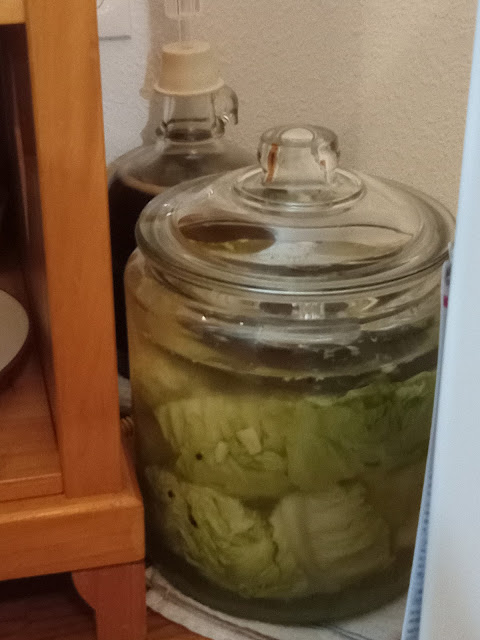Fermenting sour kraut is easy, but fermenting whole cabbages is even easier. There is no chopping involved. This method is used for fermenting large or small amounts of cabbage heads fast. The whole outer leaves are used in dishes like cabbage rolls. I will go a step further and use them to make Dolmas. Pickled grape leaves are outrageously expensive.
 |
| As I stated in my previous blog, I could only find three cabbages that had tightly packed leaves. |
 |
| Cut the core out of the center of the cabbage heads. |
 |
| Add a generous amount of salt to the center. This will aid in pickling the cabbage throughout. |
 |
| The cabbage should be packed tightly together inside the container. I cut some of my heads in half and salted them to help pack them into the crock. |
 |
| Here I am salting the cabbage halves. |
 |
| The brine solution that I am using is 2 tablespoons of sea salt for every four cups of filtered water. |
 |
| Gently poor the brine over the cabbage until it is covered by at least one inch of brine. |
 |
| Add the spices if you chose to use any. |
 |
| Once the cabbage has absorbed the brine, add more brine if needed. |
 |
| Use a plate or weights to submerge the cabbage completely. |
 |
| Place the lid on the crock. |
 |
| Store in a cool dark place. Check the brine level for a couple days to ensure that the cabbage is completely submersed. Let set for at least 40 days. |
After 40 days, check to see if the cabbage is pickled to your satisfaction. At this point, it can be stored as is in a cold room or refrigerated to slow down the fermentation process. It will continue to ferment, but at a much slower rate.
The brine solution is very good for you. It is full of probiotics and can be served as a beverage over ice. If you cannot have salt, do not drink the brine. It is salty. It is the perfect beverage after a workout or a day of exertion.
My plan is to use the larger leaves to make Dolmas, cabbage rolls or to chop it into sauerkraut. My original plan was to ferment using my 10-gallon crock, but I will have to wait until I can find enough cabbage to fill the crock. Maybe they will be abundant and on sale around St. Patrick's Day.
Enjoy,
Mrs. Smith











No comments:
Post a Comment